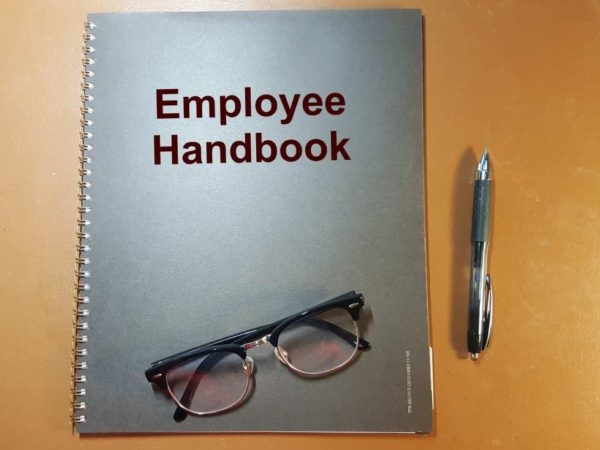— September 20, 2019

Many small businesses do not have an employee handbook, yet an employee handbook is one of the most important documents that a small business can have. Having one can prevent exposure to wrongful termination lawsuits, and be a vital tool to set proper expectations with new employees.
There is no legal requirement for a business to have an employee handbook, nor is there a mandated template a business should use. There are many templates all over the internet, each claiming to be the best. That being said, a proper employee handbook should include something similar to the following eight sections:
- Employment Basics
- Workplace Policies
- Code of Conduct
- Compensation and Development
- Benefits
- Time Off
- Resignation, Progressive Discipline, and Termination
- Acknowledgment
Employment Basics
This is an informative section of the employee handbook that establishes employment-related definitions.
The section generally starts with a greeting from the owner and how excited they are to have the employee onboard. It sets the tone for the new hire to feel welcome and can include the company’s mission, vision, and values. It ensures there is a true understanding of your business.
In this section, you will want to document the different employment types that you have, such as hourly, salary, full-time, and part-time. If you use volunteers or interns, you will want to document what constitutes each employment type. You will also want to make sure that you have an “At-Will” employment clause.
This section is also where you would document the usual hire process. For example, is your first choice to hire internally, how do you select where ads will be placed, and how will you keep applicants informed of where they are in the process? Some other questions this section should answer is if you will pay for referrals, and at what point will you run background checks and contact references. When it comes to background checks, be sure that you have the applicant’s permission.
The employment basics section should list the work location, hours of operation, and the schedule and number of hours employees are expected to work. For example, if an employee is consistently late, you will want a section that lists the expected times that company employees are expected to arrive and leave work each day. If for whatever reason, the employee cannot make it to work, you should outline the process the employee should use to contact the business and inform them they will not be coming into work.
This section is also where you may want to include a section on your nondiscrimination policy. This section must also state the rules of the Equal Employment Opportunity Commission (EEOC), which defines federal and state legislations that protect employees from discrimination such as age, race, skin color, religion, pregnancy, or disability. Here, you will outline your compliance for special accommodations for Americans with Disabilities.
Workplace Policies
The workplace policies section of the employee handbook is where you will want to outline your data protection and confidentiality policies. You will also want to detail your commitment to ensuring a harassment-free workplace that is free of any type of violence. While stating that you want a harassment and violence-free workplace may seem obvious and not worthy of being documented, the documented policy will be the evidence that you can point to in the event of a wrongful termination lawsuit.
The workplace policy section is also the place where you will want to share guidelines you want employees to follow in cases of emergencies, and your smoking and drug policies.
Code of Conduct
The code of conduct section of the employee handbook is where you will want to specify details of any dress code, safety compliance, and health code equipment employees are required to wear or use. For example, will employees be required to wear branded shirts or uniforms in public?
When it comes to data and equipment, the code of conduct section should answer questions regarding what is considered acceptable usage of your company’s computer network, the use of email for business and personal use, and personal cell phone usage at work. If you have a cyber protection policy, you should include it here.
If you require employees to use their personal vehicle and cell phones for work-related activities, the policy for mileage reimbursement, use of cell phone and accident-related activities go here.
You’ll also want to define what constitutes a conflict of interest, such as having specific types of side-hustles and the consequences for violating them.
When it comes to people, the code of conduct section should cover topics that relate to employee fraternization, working relations allowed between related parties to avoid accusations of favoritism, and how to deal with workplace visitors.
Finally, you will want to list all the reasons that are grounds for termination in the code of conduct section. Here is a partial list of situations where immediate termination for cause might apply:
- Conviction of a felony
- Failing a required alcohol or drug test
- Harassment, including sexual harassment
- Proof of giving false information
- Proof of stealing from the company or staff members
- Falsifying records
- Making threats
- Exhibiting violent behaviors
- Extreme verbal or offensive behaviors
Compensation and Development
In the compensation section of the employee handbook, you need to explain what constitutes exempt and non-exempt employment and clarify your overtime rules. You will also want to define the frequency of getting paid and how an employee will receive payment.
In the development section, you will want to define and detail how an employee’s performance evaluations are conducted, and any employee retention strategies such as the company’s commitment to employee training and development. This includes formal training, industry conferences, and mentoring programs.
Benefits
In the benefits section of the employee handbook, you will want to outline any healthcare insurance options you offer employees. If you provide a healthcare option, you will want to define eligibility, coverage levels, and how COBRA will work if they leave.
If you offer Short-Term or Long-Term Disability insurance, you will want to define that here. If you have any employee retirements benefits, such as a pension or 401K plan, you will want to define the specifics of the plan including any wait periods and business matching.
While worker’s compensation insurance is technically not a benefit, it is a legally mandated insurance. The benefits section should define the process an employee should follow if they were injured during work.
Today more and more companies offer some employees the opportunity to work from home full-time or periodically. The benefits section should outline the rules employees must follow when working remotely. This must include the need to guard confidential material, and any required cyber-security measures. If you issue any equipment to employees such as laptops or cell phone, you will need to define how they should be taken care of, if they can be used for personal use as well as for business, and what happens if the equipment is damaged, destroyed or stolen.
The benefits section is also where you will define what and how work-related expenses are handled. Furthermore, you should define how parking will be handled. Is there free parking, reserved parking areas, or do you provide an allocation for public parking? You should also document any memberships (i.e. gym memberships) or discount programs the business offers to its employees. This is also the place where you would document if you have a tuition reimbursement program.
Time Off
The time off section is the one section that employees care about the most.
If you offer employees paid vacation, the time off section is where you will define how the days are accrued and how the employee can apply to take days off. Some businesses have peak times. For example, retailers during the Christmas season may restrict vacation day usage during that time. If there are any restrictions on when vacation days can be used, they need to be documented.
If you offer company-wide holidays, you will want to list them, and define if the holidays are paid time off or unpaid. Employers as not required to pay for holiday days off but many businesses chose to provide several paid holidays per year.
When it comes to paid holidays, I have always found it useful to include a floater or discretionary holiday to cover specific ethnic or religious holidays. For example, being off for Martin Luther King Day may be important for some employees, while being off on Good Friday or Veterans Day many be important for others.
Some businesses offer employees paid leave, sick leave, bereavement leave and even time off for Jury duty. If your business employs 50 or more employees, you are required to offer 12 weeks of unpaid leave and job protection as part of the Family and Medical Leave act. This covers situations such as parental and maternity leave, as well as time to recover from serious illnesses or to care for immediate family members with serious health conditions. You are also required to document the benefits for Military Leave for active and reserve leaves. If your business offers leave to employees, this section is where you will define the policies and if they are paid or unpaid.
Employee Resignation, Progressive Discipline, and Termination
Employees may resign (leave voluntarily) or be terminated (leave involuntarily). The employee resignation subsection is where you will define what it means to give proper notice (i.e. 2-week’s notice), and how it may affect things like tuition reimbursement and/or retirements plans, such as the employee’s 401K.
The progressive discipline subsection is where you lay out the steps involved in your progressive disciplinary process, such as when a verbal warning is justified, and/or when an action warrants jumping directly to a more formal written warning or directly to immediate termination. If in the event of a wrongful termination lawsuit, the judge will use this section to determine if the termination was justified. From the employer’s point of view, this section is one of the most important sections and should not be considered lightly.
It is in your best interest to create a document that you request the employee to sign to establish if they voluntarily resign or are terminated for cause. This document would include a statement about the employee’s ineligibility for unemployment insurance.
Finally, if you have a policy about giving references to employees that resign or are terminated, you will want to document them here.
It is also a good idea to include that if an employee is terminated, especially for cause, you will not provide the employee with a reference. In this way, if you are contacted by an employer wanting to know the circumstances of the employee’s termination, you can simply say that according to company policy all you can only provide the employee’s job title, dates employed, and final salary. In this way, you cannot be accused of providing any information that could result in the former employee wanting to file a lawsuit against the company.
However, if the termination of the employee was the result of serious or criminal misconduct, violence, or theft you may want to share that. A statement such as “This employee is not eligible for any type of re-employment with our organization. This employee left under unpleasant circumstances” does not release a lot of information for a future employer but enough to be a warning. Releasing too much information exposes the business to a lawsuit from the ex-employee, and withholding the fact that the ex-employee left under unpleasant circumstances could subject the business to being sued by the new employer for covering up for an ex-employee.
It is always a good practice to include that all employees must sign a release form releasing you or further liability if you are contacted for a reference in your policy.
Acknowledgment
Make sure that the employee understands everything in your employee handbook. Have an extra copy for them and one copy for their employee record, where they initial each page and sign a statement acknowledging that they have received a copy and that all the policies were explained and understood by the employee. This signed and initialed copy will contain much of the evidence in the event of a wrongful termination suit.
Do you have an employee handbook as a reference for employees, and to protect yourself from wrongful termination lawsuits?
Business & Finance Articles on Business 2 Community
(44)





